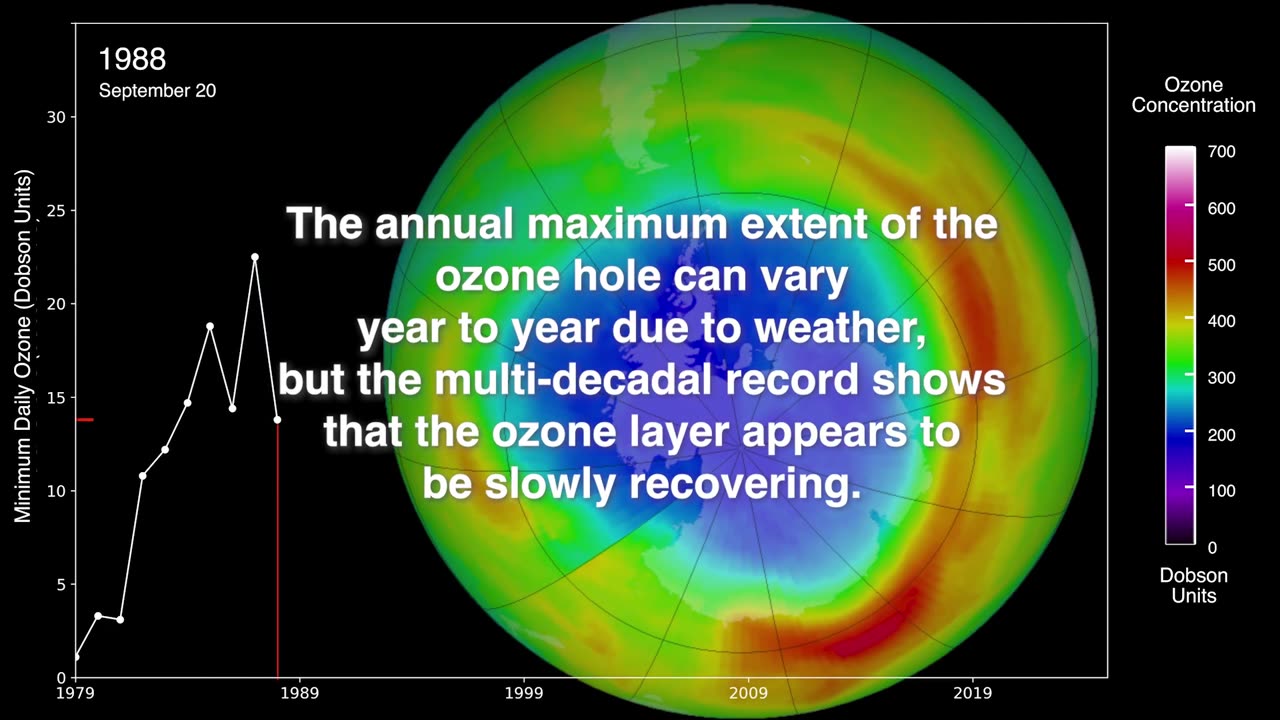Premium Only Content

NASA, NOAA 2024 Ozone Hole Update
This year, the ozone hole over Antarctica reached its annual maximum extent on September 28th, 2024, with an area of 8.5 million square miles (22.4 square million kilometers.)
The hole, which is actually a region of depleted ozone, was the 20th smallest since scientists began recording the ozone hole in 1979. The average size of the ozone hole between September and October this year was the 7th-smallest since the Montreal Protocol began to take effect.
Universal Music Production: “What Was Reported As Is”
Credit: NASA's Goddard Space Flight Center
Kathleen Gaeta (GSFC AMA): Lead Producer
Paul Newman (NASA GSFC): Lead Scientist
Amy Moran (NASA GSFC): Lead Visualizer
James Riordon (NASA GSFC): Writer
This video can be freely shared and downloaded at https://svs.gsfc.nasa.gov/14711 . While the video in its entirety can be shared without permission, the music and some individual imagery may have been obtained through permission and may not be excised or remixed in other products. For more information on NASA’s media guidelines, visit https://nasa.gov/multimedia/guidelines.
Transcript:
0:00
This year, the ozone hole over Antarctica reached its annual maximum extent on September 28th, 2024,
0:04
With an area of 8.5 million square miles (22.4 square million kilometers).
0:08
0:12
0:16
The hole, which is actually a region of depleted ozone, was the 20th smallest since scientists began recording the ozone hole in 1979.
0:20
0:24
The average size of the ozone hole between September and October this year was the 7th-smallest since the Montreal Protocol began to take effect.
0:28
0:32
The annual maximum extent of the ozone hole can vary year to year due to weather, but the multi-decadal record shows that the ozone layer appears to be slowly recovering.
0:36
0:40
“The weakening we’ve seen in the last two decades shows that international efforts that curbed ozone-destroying chemicals are working.” -Paul Newman, Chief Scientist for Earth Sciences at NASA Goddard
0:44
0:48
NASA and NOAA researchers continue to observe ozone through instruments aboard NASA’s Aura satellite, NOAA-20 satellites, and a joint NASA and NOAA satellite called Suomi-NPP.
0:52
0:56
NASA
-
 LIVE
LIVE
MattMorseTV
5 hours ago $0.26 earned🔴THE STREAMER AWARDS🔴
3,504 watching -

Side Scrollers Podcast
11 hours agoSide Scrollers Presents: QUEEN OF THE Wii
74.2K5 -
 LIVE
LIVE
TundraTactical
7 hours agoMatt Hover (CRS Firearms) Released This Week, Glock Gen 6 is Here, and More Tonight At 9pm CST
196 watching -
 LIVE
LIVE
SpartakusLIVE
4 hours agoNEW Buyback Mode is the MOST FUN I've had on WZ in YEARS
164 watching -
 LIVE
LIVE
Adam Does Movies
2 hours agoThe Best & Most Overrated Christmas Movies - LIVE!
109 watching -
 LIVE
LIVE
BubbaSZN
5 hours ago🔴 LIVE - SLAYING ZOMBIES W/ CATDOG UNTIL MY BDAY AT 12AM!
85 watching -
 LIVE
LIVE
SlingerGames
2 hours agoRumble Spartans, ASSEMBLE! | Push for 400 Followers
42 watching -
 5:22:07
5:22:07
xXFadedAngelXx
5 hours agoSPARTAN NIGHT! Featuring the Communiy! Thanks @OhHiMark! & @Phyxicx! for the invite
157 -
 LIVE
LIVE
AdmiralSmoothrod
5 hours agohalo MCC - Multiplayer Rumble No. 21 - its gonna get sticky
36 watching -
 LIVE
LIVE
BlackDiamondGunsandGear
2 hours agoNEW Glock Gen6 / Still Hate them / After Hours Armory
20 watching